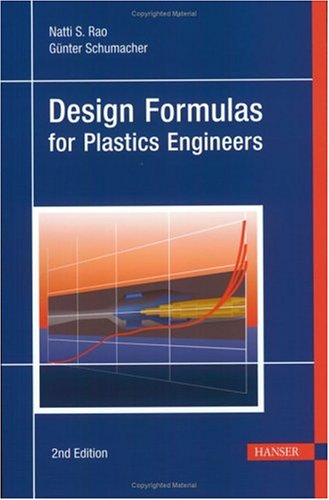Natti S. Rao, Gunter Schumacher1569903700, 9781569903704, 3446226745, 9783446226746
This book presents a summary of the most important formulas and their applications to solve design and processing problems with plastics materials. Numerous practical examples guide the reader step-by-step through the computational routine of designing polymer machinery. The approach is unassuming and very practical to enable every engineer to apply these concepts in their daily work to improve their equipment and stabilize their processes.
Table of contents :
Front Matter……Page 1
Preface……Page 3
Table of Contents……Page 0
Table of Contents……Page 4
A Final Word……Page 9
1.1 Ideal Solids……Page 10
1.2 Newtonian Fluids……Page 12
1.3 Formulas for Viscous Shear Flow of Polymer Melts……Page 13
1.3.2 Entrance Loss……Page 14
1.3.3 True Shear Stress……Page 15
1.3.5 True Shear Rate……Page 16
1.3.7.1 Hyperbolic Function of Prandtl and Eyring……Page 17
1.3.7.2 Power Law of Ostwald and de Waele……Page 18
1.3.7.3 Muenstedt’s Polynomial……Page 20
1.3.7.4 Carreau’s Viscosity Equation……Page 23
1.3.7.6 Effect of Pressure on Viscosity……Page 25
1.3.7.7 Dependence of Viscosity on Molecular Weight……Page 26
1.4 Viscoelastic Behavior of Polymers……Page 27
1.4.1.1 Linear Viscoelastic Behavior……Page 28
1.4.1.2 Nonlinear Viscoelastic Behavior……Page 32
1.4.2.1 Linear Viscoelastic Behavior……Page 34
1.4.2.2 Nonlinear Viscoelastic Behavior……Page 37
1.4.3 Maxwell Model……Page 38
1.4.4 Practical Formulas for Die Swell and Extensional Flow……Page 40
2.1 Specific Volume……Page 43
2.2 Specific Heat……Page 44
2.3 Enthalpy……Page 46
2.4 Thermal Conductivity……Page 48
3.1.1 Plane Wall……Page 50
3.1.2 Cylinder……Page 51
3.1.4 Sphere……Page 52
3.1.5 Heat Conduction in Composite Walls……Page 53
3.1.6 Overall Heat Transfer through Composite Walls……Page 56
3.2 Transient State Conduction……Page 57
3.2.1 Temperature Distribution in One-Dimensional Solids……Page 58
3.2.2 Thermal Contact Temperature……Page 64
3.3 Heat Conduction with Dissipation……Page 66
3.4 Dimensionless Groups……Page 67
3.4.1 Physical Meaning of Dimensionless Groups……Page 68
3.5 Heat Transfer by Convection……Page 69
3.6 Heat Transfer by Radiation……Page 71
3.7 Dielectric Heating……Page 74
3.8.1 Permeability……Page 76
3.8.2 Absorption and Desorption……Page 77
4.1 Strength of Polymers……Page 79
4.2 Part Failure……Page 80
4.3.1 Short-Term Stress-Strain Behavior……Page 82
4.3.2 Long-Term Stress-Strain Behavior……Page 83
5.1.1.1 Effect of Die Geometry on Pressure Drop……Page 87
5.1.1.3 General Relation for Pressure Drop in Any Given Channel Geometry……Page 89
5.1.1.4 Examples……Page 90
5.1.1.5 Temperature Rise and Residence Time……Page 100
5.1.1.6 Adapting Die Design to Avoid Melt Fracture……Page 101
5.1.1.7 Designing Screen Packs for Extruders……Page 108
5.2.1 Solids Conveying……Page 111
5.2.2 Melt Conveying……Page 115
5.2.2.2 Screw Power……Page 117
5.2.2.3 Heat Transfer between the Melt and the Barrel……Page 120
5.2.2.4 Melt Temperature……Page 121
5.2.2.5 Melt Pressure……Page 122
5.2.3.1 Thickness of Melt Film……Page 124
5.2.3.3 Dimensionless Melting Parameter……Page 127
5.2.3.4 Melting Profile……Page 128
5.2.4 Temperature Fluctuation of Melt……Page 131
5.2.5 Scale-up of Screw Extruders……Page 132
5.2.6.2 Deflection……Page 137
5.3 Injection Molding……Page 140
5.3.1 Pressure Drop in Runner……Page 141
5.3.2.1 Injection Pressure and Clamp Force……Page 144
5.3.3 Flowability of Injection Molding Resins……Page 146
5.3.4.1 Crystalline Polymers……Page 149
5.3.5.1 Thermal Design……Page 152
5.3.5.2 Mechanical Design……Page 156
5.3.6.1 Melting by Heat Conduction……Page 157
5.3.6.2 Melting during Screw Rotation……Page 158
5.3.7 Predicting Flow Length of Spiral Melt Flows……Page 163
Biography……Page 170
E……Page 171
N……Page 172
T……Page 173
V……Page 174

Reviews
There are no reviews yet.